
Facebook Twitter Instagram YouTube RSS Feed
Written on: March 5th, 2020 in Outreach

by Kenny Smith, DNREC Wetlands Monitoring & Assessment Program
Man-eating plants are a thing of sci-fi movies, they will send vines out to capture you or leap at you and consume you but back in the real-world carnivorous plants are a real thing. Our world consists of more then 600 known species of carnivorous plants that use varying tactics to capture and digest their prey1. These plants mostly consume insects but on occasion can consume small mammals, amphibians, fish, and even birds if the opportunity presents itself.
Carnivorous plants use a trapping mechanism which consists of a modified leaf that draws prey into the plant. The mechanism could be in the form of a hollow leaf with liquid to passively collect and digest prey or it could be an active trap that rapidly closes its modified leaves to catch prey. The plant then relies on bacteria or enzymes to breakdown the prey into usable nitrogenous compounds and salts1.
While these plants are carnivorous most of them still create food by photosynthesis, like other plants. The meat-eating habit or adaptation supplements the diet to counteract the poor soil and environment in which they live. Most of these plants are found in wetlands or open water environments where the nutrients available are low.
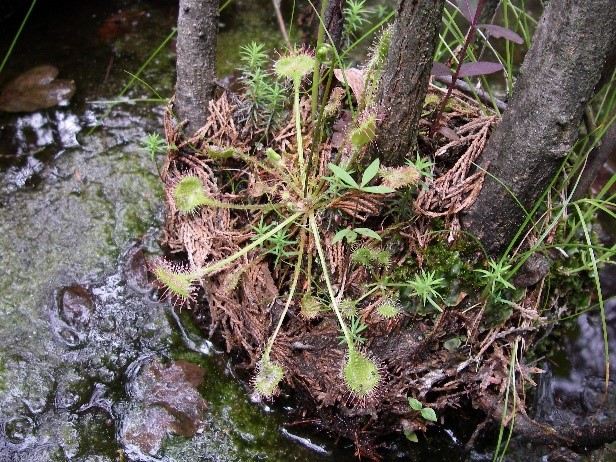
Delaware is home to 17 different species of carnivorous plants contained in 3 families; these are sundews, bladderworts, and pitcher plants. Of these 17 species, 4 species have not been found in Delaware for over 20 years and 6 species are considered extremely or very rare in Delaware2. Many of these plants are in danger of being lost due to habitat loss and over-collection3.
Read below to learn a little more about these interesting and unique plants.
There are about 152 sundew species throughout the world. Delaware is home to 4 of them, with only 2 of them found in state in the last 20 years. The Spoon-leaved Sundew (Drosera intermedia) is the most common sundew while the Roundleaf Sundew (Drosera rotundifolia) is a very rare species in Delaware2.

Both of these species are a perennial plant that can be found in Atlantic white cedar swamps, which are a unique wetland type in Delaware. Sundew species generally can survive better than other carnivorous plants in response to disturbance, which makes them one of the hardiest plants of the carnivorous plant group4.
Sundews have leaves covered in stalked glands that ooze sticky mucus. Sundews get their name from the sticky mucus appearing to glisten in the sun like a morning dew. After prey is trapped on the sticky hairs the edges of the leaves roll up to enclose the prey.
The bladderwort genus is the most diverse and widespread of all carnivorous plants with 220 species that range from temperate to tropical habitats. Although Delaware is home to 12 bladderwort species, 4 of these species are considered extremely or very rare in our landscape. The Purple Bladderwort (Utricularia purpurea) and the Not-fused Swollen Bladderwort (Utricularia inflata) are the states rarest bladderwort species 2 .
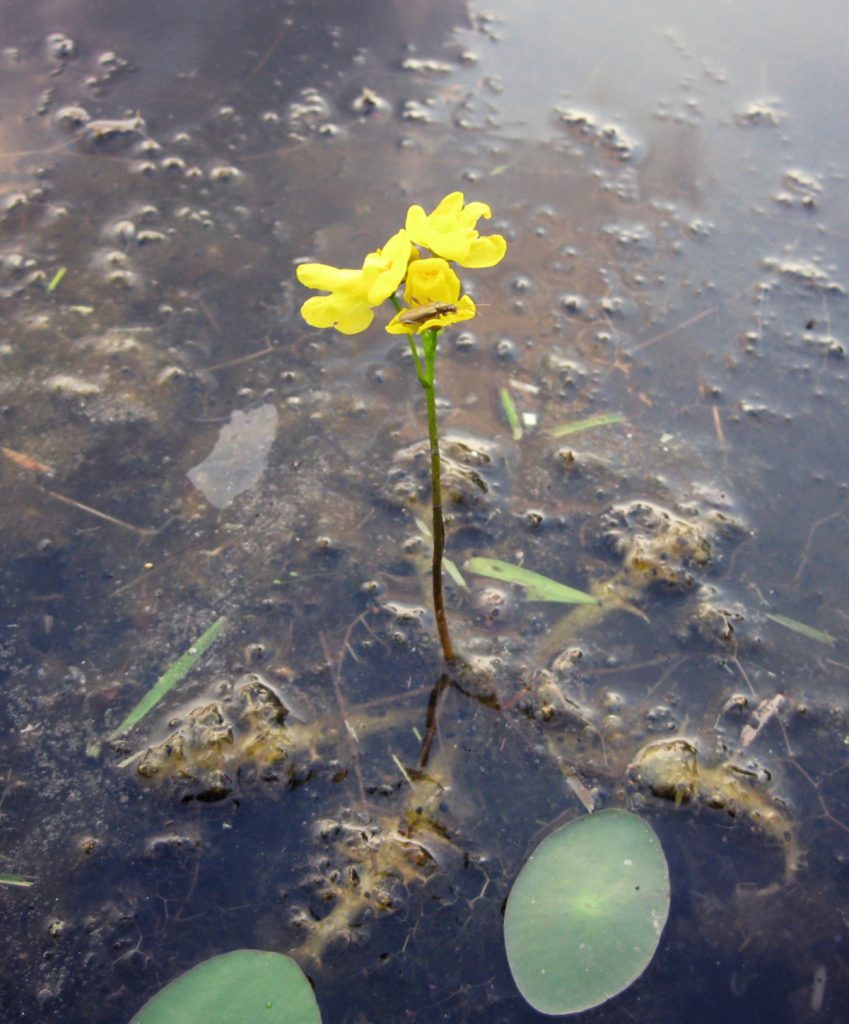
Bladderworts are usually found in open water and are an aquatic perennial plant. Bladderworts use a suction type trap. They have bladders that sit under water which contain tiny hairlike projections at the opening. When a passing prey stimulates these hairs, the plant will suddenly inflate the flattened bladder which sucks the prey in, and close a trap door to prevent escape.
Very similar to most aquatic plants that live in a climate with a cold winter they have to prepare. Bladderworts do so by creating a special bud-like structure called a turion that sinks to the bottom and awaits for warmer weather. This turion contains a mass of nearly formed leaves on a stem that has not elongated yet. This mass forms and grows in response to decreasing day-length.
Pitcher Plants can be found throughout the world but Delaware only has one species, the Northern Purple Pitcher plant (Sarracenia purpurea)2. This species is extremely rare in Delaware and can be found in Atlantic White Cedar swamps, which also happens to be a state unique and rare wetland type.
Based off the name you could guess that this plant uses a pitcher or pitfall trap to harvest prey. This pitcher mimics flowers with its coloring and puts off decaying smells of previous victims to attract flies and other insects looking for food. Once the prey enters the pitcher, they are met with a waxy surface leading to a pool of water. To prevent the insect from simply flying away, the plant supplies a wetting agent that sticks to the insect’s wings keeping it grounded3.
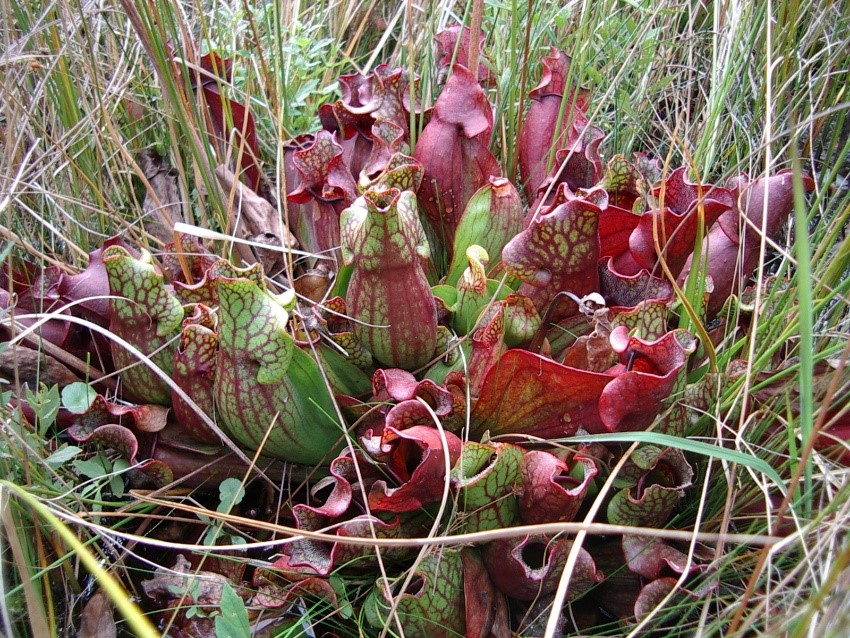
Once the meal is trapped, the pitcher plant has a couple of mechanisms to digest their food:
While the plant relies on prey falling into the leaves and decaying, many animals use the pitcher plant to fulfill a life cycle phase, like the larval stage of mosquitoes, or some frogs have been found to sit in the pitchers and consume the insects that the plant attracts.
1The Editors of Encyclopedia Britannica. “Carnivorous Plant” Encyclopedia Britannica, Encyclopedia Brittannica Inc., 18 Oct 2017, https://www.britannica.com/plant/carnivorous-plant
2McAvoy, W.A. and Bennett, K.A. The Flora of Delaware: An Annotated Checklist. Delaware Department of Natural Resources and Environmental Control, 2001
3” Carnivorous Plants/Insectivorous Plants.” Carnivorous and Insectivorous Plants Online, Drosera (Sundew), Utricularia (Bladderworts), and Sarracenia (Pitcher Plants). Botanical Society of America, https://botany.org/Carnivorous_Plants/
4Drosera Rotundifolia, Fire Effects Information System (FEIS), United States Forest Service, https://www.fs.fed.us/database/feis/plants/forb/drorot/all.html
Written on: March 5th, 2020 in Living Shorelines, Outreach, Wetland Restorations
by Erin Dorset, DNREC Wetlands Monitoring & Assessment Program
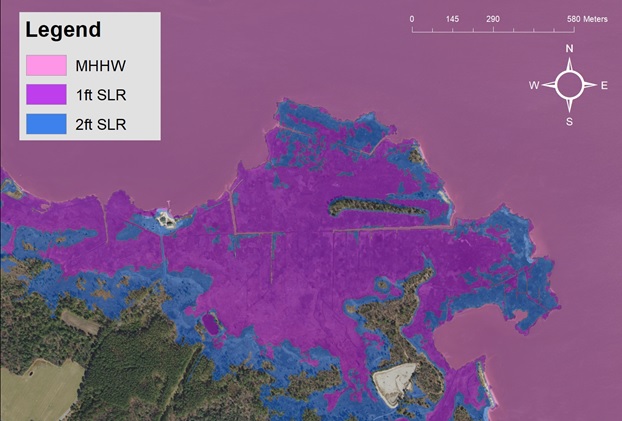
If you’re in the world of wetlands, sea level rise is a common topic of conversation. For example, here on our blog, we’ve talked about long-term monitoring efforts relating to marsh resilience in the face of rising seas and about saltwater intrusion into forested freshwater wetlands. We’ve also had a contributing author discuss effects of rising seas on trees near tidal marshes. However, sometimes we forget to stop and think about the reasons why we are experiencing sea level rise. So, let’s back up a little bit.
Sea level rise largely began with global warming, or an increase in Earth’s global temperatures. Global warming is caused by greenhouse gases absorbing and trapping solar radiation, which warms the planet more rapidly than would occur naturally. As global temperatures have risen, massive ice sheets and glaciers in Greenland and Antarctica have begun to melt rapidly, increasing sea levels. Plus, as ocean waters get warmer, they expand, further raising water levels on a global scale.
Although it is happening around the world, there are some spots that are being affected more than others. The Mid-Atlantic Coast—including Delaware—is experiencing one of the highest rates of sea level rise in the U.S, second only to the Gulf Coast.
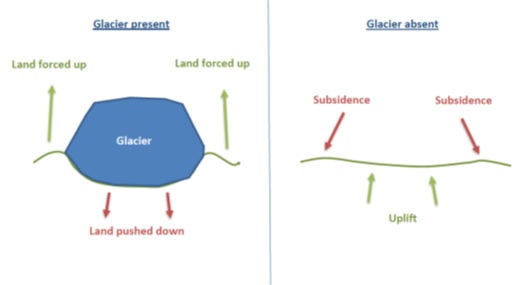
Thousands of years ago, when glaciers covered much of North America, land that was just outside of the glacial footprint—such as the Mid-Atlantic region—was forced upward as the glaciers pressed down on the land they resided upon. Once the glaciers were gone, pressure was lifted, and the land that had been forced up began to slowly sink down again. That process, called glacial isostatic adjustment, is still happening in the Mid-Atlantic today. As the land sinks, or subsides, sea levels rise even more.
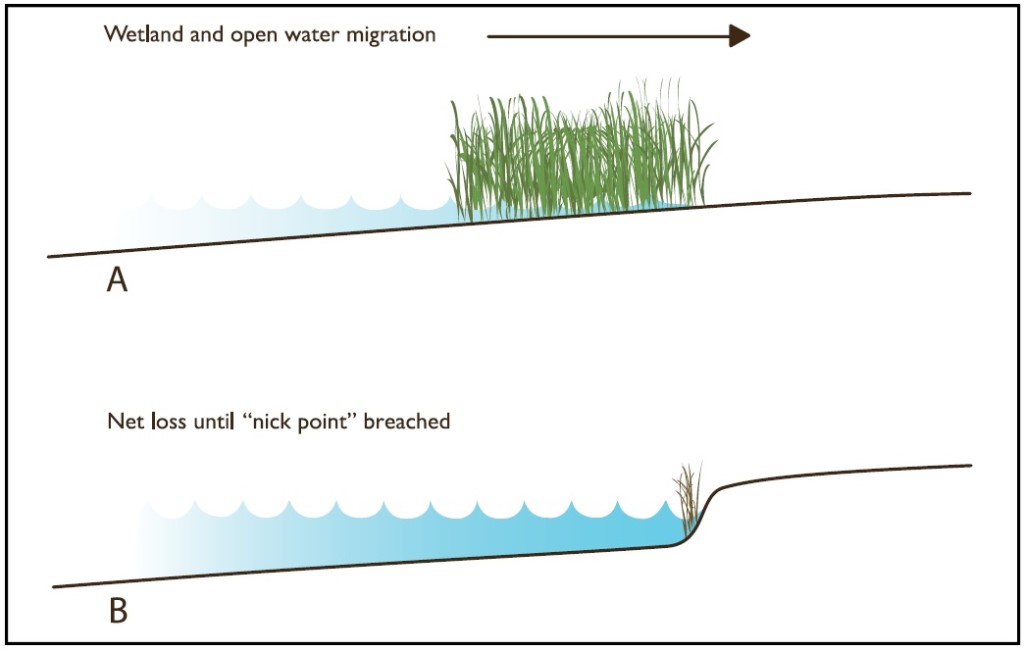
Tidal wetlands have the amazing ability to gain elevation (or height) in nature. When marsh plants die, they pile up on the marsh surface and decompose slowly, while live plants help trap and keep sediments in place and out of the water. Unfortunately, sea levels are rising too quickly in the Mid-Atlantic for many wetlands to keep up. This can result in a couple of different scenarios:
As bleak as this outlook may sound, there is hope, too. As previously mentioned, some Mid-Atlantic wetlands might be able to keep up with sea level rise by naturally gaining enough height or elevation, while others may be able to migrate inland. In places where that is not the case, scientists and land managers are looking into other ways to save or restore tidal wetlands wherever possible and make them more hardy in the face of sea level rise. A couple of these projects include:
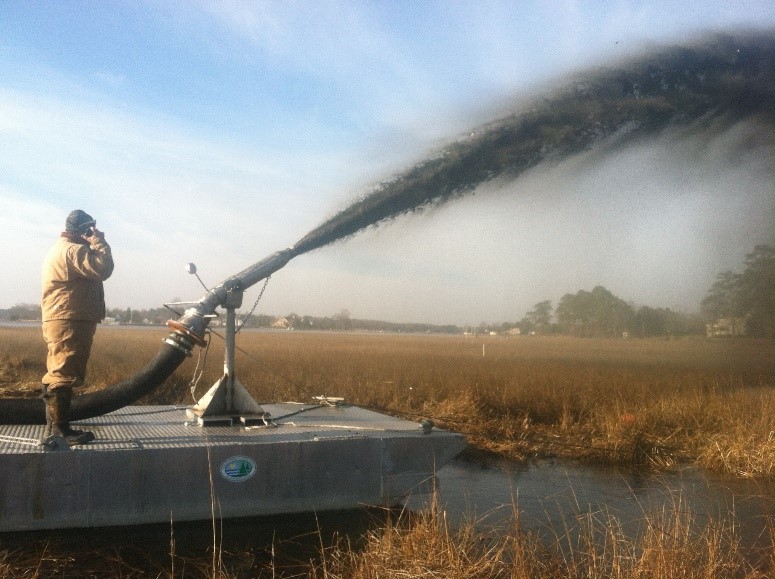
This strategy involves using dredge material to increase elevation of struggling tidal marshes to an elevation that is optimal for plant growth, which makes them more stable. Beneficial use can also be used to rebuild marshes that have been lost completely from erosion and sea level rise. See a Delaware example!
Tidal shorelines that are suffering from erosion can become stronger by using nature-based materials, such as coir logs, coir matting, and oyster shells. Look at one of the latest Delaware examples!
By incorporating the latest sea level rise projections for the Mid-Atlantic into these kinds of projects, professionals can help put our best foot forward to help coastal wetlands in our region.